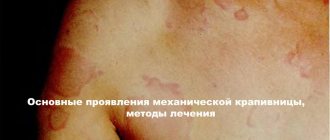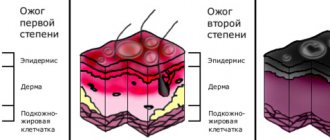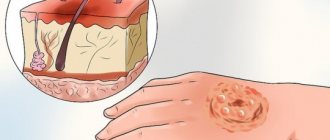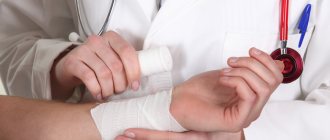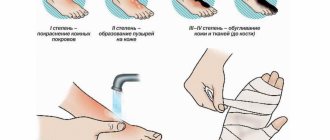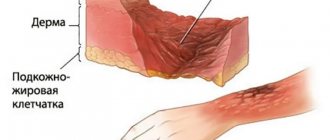Last update: 02/21/2021
The most common burns are household burns, for example, burns from electricity, boiling water and, of course, burns from chemicals and acid. An acid burn occurs when certain chemicals come into contact with the skin or mucous membranes. Chemical burns of acid to the skin of the face, hands, esophagus, larynx, eyes, and groin area are considered especially dangerous.
Classification of injury
To determine what treatment is necessary, you need to briefly describe what degrees of damage are distinguished:
- First degree burn . Redness, slight pain and swelling appear in the superficial layers of the epidermis.
- Thermal wound II degree . Severe redness, swelling, detachment of the damaged layer, formation of blisters filled with yellow liquid. The affected area heals in 11-15 days, skin pigmentation can persist for 2.5-3 weeks.
Wounds of the first two degrees are considered superficial. Their treatment is possible on an outpatient basis. They are able to heal with conservative treatment.
- IIIA degree burns are accompanied by damage to the epidermis and dermis. A light-colored scab forms. Beneath it there are noticeable pink areas - the papillae of the dermis. As the scab moves away or changes, areas covered with epithelium appear in patches. Recovery occurs after 3-6 weeks. The result is a rough scar.
- IIIB degree : skin damage, muscles are often injured. The wound is cleared of dead tissue after 4-6 weeks.
- IV degree is the most prognostically unfavorable and severe. These injuries affect the fascia, muscles, tendons and bones. The scab is thick and charring may occur. Possibly accompanied by purulent complications such as arthritis, abscesses and phlegmon.
Lesions of IIIB and IV degrees are deep wounds that require hospital stay and surgical treatment, as well as the issue of skin restoration using skin grafting. It is necessary to seek specialized help and rational treatment from appropriate specialists without delay.
Lesions of IIIB and IV degrees require hospital stay and surgical treatment.
Why do skin burns occur from household chemicals?
When purchasing detergents and cleaning products, many people pay attention only to the stated effect, but do not read the information about safety precautions and even less often study the composition. This is important, since the composition of household chemicals almost always includes ingredients that are hazardous to the skin . It can be:
- anionic surfactants;
- caustic soda;
- potassium hydroxide;
- sodium hypochlorite;
- ethylenediaminetetraacetic acid.
The presence of any of these ingredients in cleaning products requires compliance with safety precautions. They are aggressive to the skin. You can only work with these substances even for a short time while wearing gloves. Ignoring the instructions for use may result in burns. The skin is injured due to contact with reagents, and then recovers for a long time. An unsightly scar may remain at the site of the lesion.
Complications
A more serious condition in the case of deep burns occurs if they occupy more than 5-11% of the body or the total burn area is more than 20%, then in this case burn disease occurs. This disease is associated with loss of skin and profound impairment of their functions (protection against infection, loss of pain and tactile sensitivity, maintaining water balance, thermoregulation). A serious condition requires a systematic approach and comprehensive treatment aimed at preserving the life of the victim, being in intensive care conditions and a multidisciplinary approach of specialists. It is important to note that for children under one year old, 3-5% of the burn area is sufficient for this complication to appear.
How to treat the consequences of burns with household chemicals?
Some scars are completely painless and are considered a cosmetic defect, while others cause discomfort and require treatment. It is possible to smooth out the surface of the skin and lighten red-burgundy scars, but there is no talk of 100% removal of scars. Thin light stripes will most likely remain forever. This is due to the fact that when the skin is traumatized, its natural pattern is disrupted. To make the scar as invisible as possible, you can consult a dermatologist or solve the problem at home yourself.
You can get a free consultation from our specialist!
doctor Svetlana Viktorovna Ogorodnikova.
doctor
Cosmetology procedures
After burns from household chemicals, scars of all types can remain: thin normotrophic, protruding hypertrophic or keloid, as well as atrophic, reminiscent of chickenpox. The cosmetologist’s task is to even out the relief, start skin regeneration, fill the missing volume or eliminate excess scar tissue. There are different techniques available for scar correction. Here are the most effective of them:
- Laser resurfacing . The outer, pathologically altered layer of connective tissue is destroyed during the procedure. At this point, the active construction of healthy cells and the production of fresh collagen begins, due to which the skin texture is evened out. Several sessions and a serious period of rehabilitation are required, as the procedure is quite painful.
- Microdermabrasion I. Another option for hardware skin resurfacing is treatment with crystalline aluminum oxide. The upper stratum corneum is carefully removed and the formation of new cells is stimulated. The skin becomes even and smooth. Volumetric scars gradually decrease.
- Introduction of fillers . This procedure allows you to temporarily smooth out the skin texture by filling areas with atrophic scars with hyaluronic acid. Fillers stimulate tissue regeneration and collagen synthesis. After injection, the skin will become softer and more elastic.
- Acid deep peels . A special solution carefully removes the top layer of the epidermis. This helps to renew the skin and reduce the size of scars. This method is suitable for correcting atrophic scars in complex therapy.
Cosmetic procedures are effective, but removing a scar in one session will not work. The larger and brighter the scar, the more often and longer you will have to visit a dermatologist. The duration of the course also depends on the chosen technique. With laser resurfacing or microdermabrasion, 3-4 procedures are sufficient. Fillers need to be injected regularly every 6-12 months. When correcting using peelings, you will need at least 6-8 sessions. It is important to remember that all procedures have contraindications and are prescribed strictly by a specialist.
First aid for a thermal wound
First of all, when you receive a wound, you should not panic. If you are at home, to alleviate the condition, it is enough to immerse the affected areas in cold water until the pain stops . In case of a burn, your first aid kit should have the following items:
- Panthenol 5% in the form of cream or aerosol. Among the agents that can improve microcirculatory disorders and wound cooling, 5% water-soluble anilocaine ointment “Anikol” is also used. The use of antioxidants, for example Soderm ointment, vitamin E promotes faster recovery of the affected skin area.
- Sterile bandage to cover the wound.
- Hydrogen peroxide 3% or another antiseptic if the burn also causes contamination of the wound. Important! If the wound comes into contact with the ground, vaccination against tetanus is necessary.
Prevention of burns from household chemicals
The first rule of working with any detergents and cleaning products is to use rubber gloves. If an aggressive substance accidentally comes into contact with bare skin, it should be immediately washed off with running water. After using household chemicals, you must wash your hands thoroughly with soap.
If measures are taken in a timely manner, the burn will be mild. The deep layers of the skin will not have time to suffer. Contact with detergent will only cause dryness and flaking, which can be easily treated with a moisturizer or nourishing cream.
The risk of deep damage is higher if the skin is sensitive and thin. The location of the burn also plays a role. The largest scars remain when chemicals come into contact with the face, neck, chest, or inside of the wrist. Any delay in providing first aid is dangerous. Scars will remain if you do not wash off the aggressive liquid in the first minutes after it comes into contact with the body. The longer the aggressive environment remains on the skin, the deeper the trauma will be.
Modern headbands
There are a huge number of new dressings that can be used at home to promote rapid healing. The main difference from a regular bandage is that they create a favorable microclimate in the wound. After all, if the affected area of the skin dries completely, it will not speed up healing.
Branolind N with Peruvian balsam
The patch has a specific odor; it is used for wounds of 1-2 degrees; it cannot be used for necrotic damage. You can change the bandage once every two days. A contraindication is an allergic reaction to the patch, manifested by redness and swelling.
Hydrocoll
Gel dressing, which is used for 1-2 degree burns. The package contains a 15x15 cm bandage that can be adjusted to the size of the wound. The bandage should cover the damaged area by 1-2 cm.
Silkoplast Comfort IT-Burn
Used for grade 1-2 wounds, relieves pain and promotes rapid healing.
Types of chemical burns
Taking into account the characteristics of the damaging substance, the following types of damage are distinguished:
- Acidic.
When it comes into contact with the skin, the acid causes the protein to coagulate. As the protein breaks down, it forms a dense crust that prevents the substance from penetrating deep into the tissue. Therefore, such burns are usually shallow. - Alkaline.
Improper handling of caustic soda, quicklime, and ammonia leads to serious consequences. The aggressive substance corrodes tissue, causing deep damage. Such wounds heal more slowly than other burns. - Burns from heavy metal salts.
Less dangerous compared to previous species. Damage is limited to the outer layer of the skin. - Phosphoric.
Upon contact with the skin, the substance ignites, leaving behind a deep wound.
In the absence of first medical aid, the substance continues to destroy the integrity of the integument. Removing the chemical from the skin is not enough to stop the reaction; only inactivation will help.
Symptoms
The very first and “harmless” signs of a chemical burn are redness of the mucous membrane and burning, as well as blepharospasm (the patient cannot open his eyes).
Typical symptoms for chemical burns of any origin are :
- photophobia;
- blurred vision;
- decreased visual acuity;
- swelling of the eye;
- change in color of the cornea and mucous membrane;
- paleness of the cornea of the eye;
- the appearance of scars over time.
Sometimes, as a consequence of a chemical burn, cataracts or glaucoma can develop, and even after taking all therapeutic measures, gradual and inevitable death of the eyeball (subatrophy) can occur.
Important! Eye burns mainly occur during work at various manufacturing plants, where a person comes into contact with various chemicals.
But you can also get such an injury at home (for example, when doing eyelash extensions or getting household detergents or alcohol in your eyes).
Consequences
If the burn was caused by an acid or alkali, a crust forms in its place, which has its own name - a scab.
Alkalies in contact with skin are much more dangerous than acids, because... they quickly penetrate into the deep layers of tissue, causing serious damage.
- If the burn was caused by alkali, the color of the scab is whitish, without clear boundaries, with an imperceptible transition to adjacent healthy tissue. The texture of the scab is soft and loose; it hardens much later.
- When exposed to acid, the scab looks different - from dense, hard and dry. The border is clearly defined, the transition to healthy areas of the skin is visible to the naked eye. Typically, such injuries are superficial, which speeds up recovery.
The color of the tissue in the affected area depends on the type of chemical:
- When sulfuric acid comes into contact with the skin, the burn is initially white, then turns gray or brown.
- When exposed to nitrogen acid, the burn will be light yellow, with a greenish or brown tint.
- When skin comes into contact with hydrochloric acid, a yellow burn is formed;
- Acetic acid leaves off-white burns when it comes into contact with the skin;
- After carbolic acid, white traces remain, which subsequently become brown;
- Concentrated hydrogen peroxide leaves dirty-gray burns.
It is useful to study and remember the differences in burns by color so that in a critical situation you can quickly determine the type of composition that burned the skin. This will help minimize harm or even save lives.
When chemicals get on the skin, their effect continues for some time after contact has been stopped (the wound is washed, a bandage is applied).
This is due to the peculiarities of the functioning of our tissues - the absorption of the substance does not stop instantly, which makes it much more difficult to determine the degree of the burn.
Sometimes the substance continues to act for several hours or even days - so it is very difficult to immediately draw conclusions about the depth of the damage. As a rule, it is possible to accurately determine the extent of the burn only 1-1.5 weeks after the injury - by this time the scab begins to suppurate, which is one of the parameters when determining the depth of the damage.
The severity of a burn from contact with chemicals depends on two key characteristics - depth and area. Chemical burns themselves are usually deep, and if they are also large, this aggravates the situation.
Skin restoration
After a burn, a blister containing a colorless liquid may form on the skin. Its proper treatment will help avoid an inflammatory and purulent reaction. Under the neoplasm there will be a renewed skin layer; after 8-10 days, the damaged part will dry out and fall off.
In place of the blister, new skin will appear in the form of a pink spot. The renewed skin area is usually very sensitive, so it is recommended to treat it with special creams and ointments that promote effective and safe recovery.
Failure to provide first aid in a timely manner can lead to disappointing consequences. An infection will appear at the burn site, the resulting blister will become inflamed and begin to fester. The phenomenon usually entails fever, poor health, chills and weakness. The wound will heal slowly and recovery may take too long. In order to avoid serious complications, you should not hesitate, you need to urgently contact a specialist, who, in turn, will conduct tests and prescribe the correct treatment.
Burn disease
Medical care for burns also includes treatment of burn disease. The destruction of tissue is accompanied by the release of toxins that poison the body. As a result, the functioning of internal organs is disrupted, primarily the liver, spleen, kidneys, and heart. Massive infusion therapy is needed, aimed at quickly removing decay products and maintaining the functioning of internal organs.
Regardless of the area and depth of the burn, the injury itself does not pose a danger to human life. But with extensive and deep lesions, there may be a deterioration in the quality of life. It is burn disease that poses the greatest danger, so its treatment and prevention should be given the greatest attention.
Characteristics and causes of burns
Any chemical damage is caused by contact of hazardous substances with the skin. The following reagents act as aggressive factors:
- acids or alkalis;
- gasoline and kerosene;
- bitumen;
- phosphorus.
Short exposure is nothing to worry about, but longer exposure will affect the surface of the skin. The longer the substance is in contact with tissue, the greater the degree of damage. Also, the condition of the victim depends on the concentration in which the reagent is presented. Upon contact, proteins are destroyed, causing tissue death.
The injury manifests itself as progressive inflammation, the formation of blisters, wounds and ulcers. Without help, muscle structures, joints, even bones are damaged. If you notice in time that gasoline has come into contact with your skin, serious injuries can be avoided. If you ignore the substance getting on the surface of the skin, this can lead to extensive injuries. The components are absorbed quickly and spread not only to the skin, but also to the mucous membranes.
How to understand what exactly got into your eyes?
In order not to waste precious time finding out the cause, it is better to consult a doctor as soon as possible. It is very difficult to visually determine what caused the burn. For example, if there are crusts, one can only assume that acid has gotten into the eyes, but in reality it is difficult to see them. Everything is complicated by the fact that due to the reflex, the eyelids are tightly closed during a burn. Therefore, the conclusion is usually made based on what the person has worked with. If the victim has used ammonia bleaches, cleaners, lime, cement or magnesium, this is definitely an alkaline injury.
Symptoms of the lesion
In most cases, the injury occurs on the arms or legs, less often on the chest, abdomen or mucous membranes. Such injuries are considered serious and require medical intervention and hospitalization. Getting gasoline into the eyes causes serious complications, including loss of vision, so you should not hesitate if you have the first symptoms.
Signs depend on the degree of damage and the extent of the wound. The following stages with different manifestations are distinguished:
- in the first degree, no significant tissue damage is formed. The injury is localized in the upper layers of the skin. Symptoms include redness, swelling, and burning. Sometimes patients complain of minor pain;
- the second degree is characterized by more extensive damage. At this stage, victims are faced not only with redness, but also with the formation of blisters, most often filled with transparent contents;
- The third degree is characterized by severe damage to all skin. Deeper tissues suffer. Patients complain of blisters with purulent contents and severe pain. Tissue necrosis begins;
- at the fourth degree, irreversible processes occur. The reagent penetrates into muscles, tendons, and bones. Victims report severe pain.
Useful video
From this video you will learn more about the consequences and proper treatment of chemical eye burns:
Self-medication for chemical burns is unacceptable. The only thing that the victim must do independently or with outside help is to rinse the damaged eyes with plenty of water.
After this, you need to wait for a doctor who can provide professional assistance and prescribe a further course of treatment. In this case, even with severe burns, vision can be preserved or restored.

